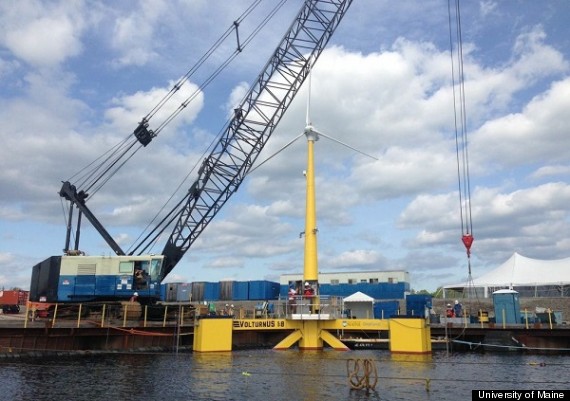First Floating Wind Turbine In The U.S. Deploys In Maine
Posted by Big Gav in floating offshore wind power, floating wind power, wind power
The HuffPo has a post on a floating wind power pilot project in the US - First Floating Wind Turbine In The U.S. Deploys In Maine (from back in April - needless to say time is not of the essence here in recent years).
The first floating wind turbine in U.S. history went upright and onto the water in Brewer, Maine, on Friday, on its way to being put in place and connected to the grid off the coast near the town of Castine.The 65-foot-tall VolturnUS 1:8 prototype is a small-scale model of the giant 6-megawatt turbines the University of Maine’s Advanced Structures and Composites Center and its partners in the DeepCWind Consortium hope to have in the water someday. Deep-water wind supporters in Maine believe that by 2030 they can grab 5 gigawatts of power with arrays of large turbines up to 50 miles off the coast, away from conflicts and where the winds blow strong and consistent. ...
Floating turbines are seen as a next logical step in offshore wind development. Standard offshore turbines are nearly always installed in waters less than 30 meters deep, but deeper water accessible only with floating turbines could offer even better wind as well as fewer stakeholder and aesthetic conflicts. A couple of demo floating projects have launched in Europe, one by Energias de Portugal and Principle Power off Portugal and the world’s first, in 2009, Statoil’s Hywind.
Beyond this smaller-scale pilot, DeepCWind is planning to build two of the 6-megawatt full-sized turbines in the 2015-17 period. To aid in that effort, this past December the U.S. Department of Energy gave the university a $4 million grant (at the same time it backed the Oregon floating project), and other such projects are brewing around the world.
Ultimately, the Maine group aims to have some 80 turbines floating in 4-mile by 8-mile zone 20 miles from the coast. The team figures those turbines will be able to produce electricity at 10 cents per kilowatt-hour without subsidies, meeting a 2020 goal of the DOE.






